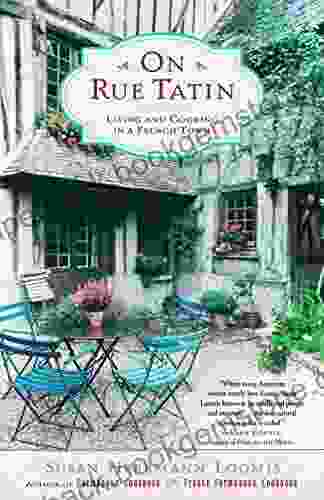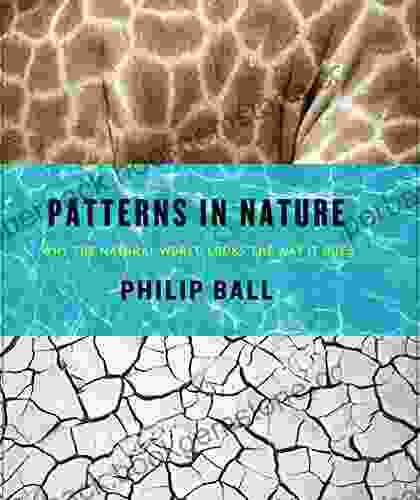Why The Natural World Looks The Way It Does: Unraveling the Secrets of Nature's Aesthetics

Prologue: A Tapestry of Beauty
From the vibrant hues of blooming flowers to the majestic grandeur of towering mountains, the natural world captivates us with an unparalleled symphony of colors, forms, and patterns. It is a realm where beauty unfolds in countless ways, stirring within us a sense of wonder and awe. But why does the natural world look the way it does? What forces have shaped its aesthetic tapestry, giving rise to the breathtaking diversity we witness today?
4.6 out of 5
| Language | : | English |
| File size | : | 104868 KB |
| Text-to-Speech | : | Enabled |
| Screen Reader | : | Supported |
| Enhanced typesetting | : | Enabled |
| X-Ray | : | Enabled |
| Word Wise | : | Enabled |
| Print length | : | 348 pages |
| Lending | : | Enabled |
Chapter 1: The Canvas of Evolution
At the heart of nature's aesthetics lies the relentless force of evolution. Over millions of years, species have adapted to their surroundings, developing traits that enhance their survival and reproductive success. These adaptations have often resulted in striking visual attributes, from the intricate patterns on a butterfly's wings to the aerodynamic form of a bird in flight.
Consider the vibrant coloration of many flowers. These colors serve as beacons, attracting pollinators essential for the plant's reproduction. Similarly, the sharp thorns on rose stems deter herbivores, protecting the plant's delicate buds and blooms.
Chapter 2: The Symphony of Environmental Factors
The environment plays a profound role in shaping the natural world's aesthetics. From the interplay of light and shadow to the influence of temperature and humidity, environmental factors can alter the appearance of organisms in countless ways.
Sunlight, for instance, is a primary determinant of plant coloration. Chlorophyll, the pigment responsible for photosynthesis, absorbs blue and red wavelengths of light, reflecting green. However, certain plants produce additional pigments, such as carotenoids and anthocyanins, which absorb different wavelengths and give rise to a wide spectrum of hues, from yellow to purple.
Chapter 3: The Dynamic Dance of Ecological Interactions
The natural world is a vast network of interconnected organisms, and these interactions can significantly influence their appearance. Predation, competition, and mutualism all play a role in shaping the visual characteristics of species.
For example, the intricate mimicry exhibited by some animals, such as the stick insect or the poison dart frog, has evolved to deceive predators or attract prey. Similarly, the formation of symbiotic relationships, such as the partnership between certain ants and acacia trees, can lead to the development of unique structures that benefit both species.
Chapter 4: The Role of Visual Perception
Our perception of the natural world is not objective but rather filtered through the lens of our visual system. The way we see colors, shapes, and patterns is influenced by our physiology, psychology, and cultural background.
Certain colors, such as red and yellow, have been shown to elicit strong emotional responses in humans. Similarly, the human eye is particularly sensitive to certain geometric shapes, such as circles and spirals, which can create a sense of harmony and balance.
Chapter 5: The Beauty in the Eye of the Beholder
The appreciation of nature's beauty is subjective and varies widely among individuals and cultures. What one person finds aesthetically pleasing, another may find mundane. This subjectivity is influenced by factors such as personal experiences, cultural norms, and individual preferences.
For some, the beauty of nature lies in its simplicity and purity, while others may find solace in its untamed wilderness. Ultimately, the natural world offers a boundless canvas for our imaginations, allowing each of us to find inspiration and meaning in its diverse forms.
Epilogue: A Legacy of Wonder and Inspiration
The beauty of the natural world has captivated humanity for millennia, inspiring countless works of art, literature, and music. From ancient cave paintings to modern-day nature documentaries, humans have expressed their awe and appreciation for the intricate tapestry of nature's aesthetics.
As we continue to explore and understand the natural world, we can deepen our appreciation for its beauty and marvel at the complex interplay of forces that have shaped it. The natural world stands as a perpetual source of wonder and inspiration, reminding us of the interconnectedness of all life and the profound beauty that surrounds us.
4.6 out of 5
| Language | : | English |
| File size | : | 104868 KB |
| Text-to-Speech | : | Enabled |
| Screen Reader | : | Supported |
| Enhanced typesetting | : | Enabled |
| X-Ray | : | Enabled |
| Word Wise | : | Enabled |
| Print length | : | 348 pages |
| Lending | : | Enabled |
Do you want to contribute by writing guest posts on this blog?
Please contact us and send us a resume of previous articles that you have written.
 Best Book
Best Book Page Flip
Page Flip Bookshelf
Bookshelf Literary loom
Literary loom Chapter
Chapter Bookish
Bookish PageTurner
PageTurner Bibliophile
Bibliophile Story
Story Inkwell
Inkwell Bookworm
Bookworm Labyrinth
Labyrinth Plot Twist
Plot Twist Prose
Prose Paperback
Paperback Storyteller
Storyteller Sanctuary
Sanctuary Fiction
Fiction Reading
Reading Chronicle
Chronicle Read
Read Susan Herrmann Loomis
Susan Herrmann Loomis Eric Gibson
Eric Gibson Blair Howard
Blair Howard Seymour Morris Jr
Seymour Morris Jr Brandon Varnell
Brandon Varnell Baby Professor
Baby Professor William Black
William Black Jamie Davis
Jamie Davis Briana Wiles
Briana Wiles Momoyo Nishimura
Momoyo Nishimura Lorraine De Meaux
Lorraine De Meaux Josephine B Pasquarello
Josephine B Pasquarello Tya Marie
Tya Marie Denis Dutton
Denis Dutton Stuart D Paine
Stuart D Paine Lucinda Fleeson
Lucinda Fleeson Spencer Shaw
Spencer Shaw Ben Strand
Ben Strand Bruce Hanington
Bruce Hanington Barbara Casey
Barbara Casey Noret Flood
Noret Flood J Dominique
J Dominique Khadijah J
Khadijah J Deborah Forman
Deborah Forman Rexford Govorchin
Rexford Govorchin Brad Bussie
Brad Bussie Dave Hickey
Dave Hickey Baoshu
Baoshu Monica Walters
Monica Walters Staci Swider
Staci Swider Ruth Superhal
Ruth Superhal Russell Foureagles
Russell Foureagles Michael Wise
Michael Wise Erica Davies
Erica Davies Tiana Bighorse
Tiana Bighorse Beatrice Sonders
Beatrice Sonders John G Breslin
John G Breslin Sophie Cunningham
Sophie Cunningham Steve Ryfle
Steve Ryfle Jordan Marie
Jordan Marie Esmeralda Santiago
Esmeralda Santiago Carol Sulcoski
Carol Sulcoski Michael J Hayde
Michael J Hayde Fiona Peart
Fiona Peart Ben Shahn
Ben Shahn Maggie Craft
Maggie Craft Wilkie Collins
Wilkie Collins Benjamin Lewin
Benjamin Lewin Pam Flowers
Pam Flowers Bob Dow
Bob Dow Emily Spivack
Emily Spivack Betsy Prioleau
Betsy Prioleau Grace Berry
Grace Berry Orestes Lorenzo
Orestes Lorenzo Jonathan C Slaght
Jonathan C Slaght C Pierce Salguero
C Pierce Salguero Greg Mitchell
Greg Mitchell Hal Erickson
Hal Erickson James Ulyatt
James Ulyatt Katie Dowe
Katie Dowe Maura Spiegel
Maura Spiegel Micah Ian Wright
Micah Ian Wright Jessie Knadler
Jessie Knadler Robert Muirhead
Robert Muirhead Tim Stokes
Tim Stokes Charles Sturt
Charles Sturt Olive Yong
Olive Yong Robert Crais
Robert Crais Taylor Jenkins Reid
Taylor Jenkins Reid Tim Powers
Tim Powers Shoko Tendo
Shoko Tendo Florencia E Mallon
Florencia E Mallon Iris Murdoch
Iris Murdoch Kolbie Blume
Kolbie Blume Ian Nathan
Ian Nathan Shane Mitchell
Shane Mitchell Barbara Grizzuti Harrison
Barbara Grizzuti Harrison Bella Martin
Bella Martin Jonathan Waterman
Jonathan Waterman Paula Kamen
Paula Kamen Fania E Davis
Fania E Davis Samuel Peralta
Samuel Peralta Bart King
Bart King Chris Roel
Chris Roel Deanne Stillman
Deanne Stillman D L Harrison
D L Harrison Joan Williams
Joan Williams Ravyn Wilde
Ravyn Wilde George Schindler
George Schindler Lucy Jane Bledsoe
Lucy Jane Bledsoe Kevin Hart
Kevin Hart Keith Doyle
Keith Doyle Diane Tuckman
Diane Tuckman S L Rowland
S L Rowland Conn Iggulden
Conn Iggulden Beebe Bahrami
Beebe Bahrami James Haddock
James Haddock Marty Noble
Marty Noble Edward White
Edward White Dalili
Dalili Matthew Morgante
Matthew Morgante James Goddard
James Goddard Barbara Hambly
Barbara Hambly Philip Guston
Philip Guston Cornelius C Kubler
Cornelius C Kubler Benjamin Hochman
Benjamin Hochman Interweave Editors
Interweave Editors Jenny Mckay
Jenny Mckay Bob Elliott
Bob Elliott Lena Corwin
Lena Corwin Marvin Patchen
Marvin Patchen Partha Mitter
Partha Mitter Lynne Anne Blom
Lynne Anne Blom Jeremy Dronfield
Jeremy Dronfield Sir Richard Francis Burton
Sir Richard Francis Burton Bill H Myers
Bill H Myers Matthew Luzi
Matthew Luzi Kathy Mckeon
Kathy Mckeon Keith Houston
Keith Houston David Elliot Cohen
David Elliot Cohen Tom Wilson
Tom Wilson Bella Young
Bella Young Ilan Stavans
Ilan Stavans Bill Lee
Bill Lee Catherine Ryan Hyde
Catherine Ryan Hyde Steve Huston
Steve Huston Paraluman S Aspillera
Paraluman S Aspillera Jay Armstrong
Jay Armstrong Jon Contino
Jon Contino Tim Rayborn
Tim Rayborn Dave Hill
Dave Hill Eric Rauchway
Eric Rauchway Mary Peters
Mary Peters Peter Ustinov
Peter Ustinov Behrouz Boochani
Behrouz Boochani Stewart M Green
Stewart M Green Nikki Turner
Nikki Turner Zongyan Hu
Zongyan Hu Barbara Raue
Barbara Raue Jane Pek
Jane Pek Stephen Haff
Stephen Haff Ian Mcdonald
Ian Mcdonald Wassily Kandinsky
Wassily Kandinsky Mary Lou Andre
Mary Lou Andre Hayao Miyazaki
Hayao Miyazaki Robin Cormack
Robin Cormack Benjamin E Wise
Benjamin E Wise Sara Boccaccini Meadows
Sara Boccaccini Meadows Mary Brave Bird
Mary Brave Bird Elisabeth Elliot
Elisabeth Elliot Ruth Silvestre
Ruth Silvestre Shing Schih
Shing Schih Bella Blair
Bella Blair Bill Arnott
Bill Arnott Alan O Brien
Alan O Brien Barbara Chase Riboud
Barbara Chase Riboud Billie Holiday
Billie Holiday Sarah Mirk
Sarah Mirk David Byrne
David Byrne Shirtaloon
Shirtaloon Malala Yousafzai
Malala Yousafzai Thomas S Hischak
Thomas S Hischak Laurent Bolard
Laurent Bolard Bill Winner
Bill Winner Ben D Over
Ben D Over Robert Henderson
Robert Henderson J P Telotte
J P Telotte Barry Sonnenfeld
Barry Sonnenfeld Lexi Sundell
Lexi Sundell Barry Herniman
Barry Herniman Bobby Brown
Bobby Brown Mario Rizzi
Mario Rizzi Michael Chatfield
Michael Chatfield Carol Huber Cypher
Carol Huber Cypher Mariana Atencio
Mariana Atencio Peter Inglis
Peter Inglis Merl Code
Merl Code Kyle Froman
Kyle Froman Hillary Jordan
Hillary Jordan Leo Buijs
Leo Buijs Barrington Barber
Barrington Barber Bayard Taylor
Bayard Taylor Sejal Shah
Sejal Shah Terry Compton
Terry Compton Philip Ball
Philip Ball Barbara Miller
Barbara Miller Mateo Askaripour
Mateo Askaripour Leanne Kitchen
Leanne Kitchen Charles A Perrone
Charles A Perrone Chevonne Clarke Bryan
Chevonne Clarke Bryan Birgit O Connor
Birgit O Connor Bj Wane
Bj Wane Ken Browar
Ken Browar Sophia Rolle
Sophia Rolle Joanne Hutchinson
Joanne Hutchinson Yahrah St John
Yahrah St John Nolan Clark
Nolan Clark Jason Sperb
Jason Sperb Ben Eastham
Ben Eastham Blaise Corvin
Blaise Corvin Bet Borgeson
Bet Borgeson Ellen Tomaszewski
Ellen Tomaszewski Saul Tanpepper
Saul Tanpepper Justin Woolley
Justin Woolley Robert Roskind
Robert Roskind Loring M Danforth
Loring M Danforth Bob Drury
Bob Drury Eric Henze
Eric Henze Nelson Demille
Nelson Demille Bill Bryson
Bill Bryson F Scott Fitzgerald
F Scott Fitzgerald Christopher Butler
Christopher Butler Stuart Williams
Stuart Williams Steven Campbell
Steven Campbell Lisa Congdon
Lisa Congdon Bolu Babalola
Bolu Babalola Bernth Lindfors
Bernth Lindfors Gavin Maxwell
Gavin Maxwell Lonely Planet
Lonely Planet John Seed
John Seed Tessa Miller
Tessa Miller Maxime J Durand
Maxime J Durand Tim Rangnow
Tim Rangnow Jenna Fischer
Jenna Fischer Talia Hibbert
Talia Hibbert Bassey Ikpi
Bassey Ikpi Beverly J Armento
Beverly J Armento Helmut Kopka
Helmut Kopka Lucee Joie
Lucee Joie Bill Cotter
Bill Cotter Jennie Smallenbroek
Jennie Smallenbroek Betsy Dillard Stroud
Betsy Dillard Stroud William A Kappele
William A Kappele Ben Hannam
Ben Hannam Nefertiti Austin
Nefertiti Austin Mark Tufo
Mark Tufo Harmon Cooper
Harmon Cooper Barry Lord
Barry Lord Diane Duane
Diane Duane Tony Horwitz
Tony Horwitz Gerri Leen
Gerri Leen Elena Gorokhova
Elena Gorokhova Yiyun Li
Yiyun Li Tove Ditlevsen
Tove Ditlevsen Mary Matsuda Gruenewald
Mary Matsuda Gruenewald Clifford D Simak
Clifford D Simak John Scarne
John Scarne Yvonne Blackwood
Yvonne Blackwood Blakely Little
Blakely Little Tammy Ruggles
Tammy Ruggles Darrel Rees
Darrel Rees George Lopez
George Lopez Boris Mihailovic
Boris Mihailovic Paul Kendall
Paul Kendall Greg O Brien
Greg O Brien J C Sum
J C Sum Barbara A Parish
Barbara A Parish Phoebe Robinson
Phoebe Robinson Barbara Demick
Barbara Demick Becky Gilhespie
Becky Gilhespie Thomas P Stafford
Thomas P Stafford Tom Sito
Tom Sito Matthew J Milliner
Matthew J Milliner Marina Warner
Marina Warner Gary Wasserman
Gary Wasserman Barney Nelson
Barney Nelson Joseph Lanza
Joseph Lanza Ottessa Moshfegh
Ottessa Moshfegh Zachary Leader
Zachary Leader Sandra Duran Wilson
Sandra Duran Wilson Glynn Stewart
Glynn Stewart Leon Smith
Leon Smith Toni Ann Johnson
Toni Ann Johnson Joan Reardon
Joan Reardon Robert Morkot
Robert Morkot Sarah Birnbach
Sarah Birnbach Elaine A Clark
Elaine A Clark Joseph M Henninger
Joseph M Henninger Kao Kalia Yang
Kao Kalia Yang Tony Burton
Tony Burton Barry Kirwan
Barry Kirwan Rita Benn
Rita Benn Bil Donovan
Bil Donovan Louis Wain
Louis Wain Helen Hoang
Helen Hoang Joseph Heywood
Joseph Heywood Hakeem M Oluseyi
Hakeem M Oluseyi Maggie Ramsay
Maggie Ramsay C J Boyle
C J Boyle Daniel Rachel
Daniel Rachel Koloman Moser
Koloman Moser Tershia Lambrechts
Tershia Lambrechts Linda Lael Miller
Linda Lael Miller Bob Normand
Bob Normand Patrick Symmes
Patrick Symmes Laney Salisbury
Laney Salisbury Bernice L Mcfadden
Bernice L Mcfadden Jessica Marting
Jessica Marting Mike Curato
Mike Curato Larissa Pham
Larissa Pham Robert Lanz
Robert Lanz Charlise Lyles
Charlise Lyles Richard Sorger
Richard Sorger Ben Box
Ben Box Robert E Hampson
Robert E Hampson Matthew Brehm
Matthew Brehm Claude Lanzmann
Claude Lanzmann Hope Hart
Hope Hart Jan V White
Jan V White Stephen C Baldwin
Stephen C Baldwin Matt Smith
Matt Smith Norman Lee
Norman Lee Beth Tondreau
Beth Tondreau Dean Koontz
Dean Koontz Barbara Delinsky
Barbara Delinsky Mackenzie Phillips
Mackenzie Phillips Lucy Adlington
Lucy Adlington Chris Nashawaty
Chris Nashawaty John Muir
John Muir Silvia Marina Arrom
Silvia Marina Arrom Laurie Gough
Laurie Gough Eva Tulene Watt
Eva Tulene Watt Bob Herbert
Bob Herbert Tori Rodriguez
Tori Rodriguez William Alexander
William Alexander Dori Jones Yang
Dori Jones Yang Betty Dooley Awbrey
Betty Dooley Awbrey Ceidrik Heward
Ceidrik Heward Bill Plympton
Bill Plympton Rainer Maria Rilke
Rainer Maria Rilke Ernst Rettelbusch
Ernst Rettelbusch Wendy Tait
Wendy Tait Deirdre Slattery
Deirdre Slattery Bianca Del Rio
Bianca Del Rio Jacinda Townsend
Jacinda Townsend Elissa Washuta
Elissa Washuta Ros Per
Ros Per William Ellis
William Ellis Betsy Beier
Betsy Beier Poppy Evans
Poppy Evans Jennifer Wilson
Jennifer Wilson Beau Riffenburgh
Beau Riffenburgh Mark Crilley
Mark Crilley Lesley Downer
Lesley Downer Dennis E Taylor
Dennis E Taylor Bich Minh Nguyen
Bich Minh Nguyen Terese Marie Mailhot
Terese Marie Mailhot Tom Wiener
Tom Wiener Barbara Lewis
Barbara Lewis Bebe Harper
Bebe Harper Philip B Meggs
Philip B Meggs Jpinsiders
Jpinsiders Betsy Whyte
Betsy Whyte Kerry Bogert
Kerry Bogert Yoshitaka Amano
Yoshitaka Amano Debbie Rose Myers
Debbie Rose Myers Suzette Riddick
Suzette Riddick Lynne Olson
Lynne Olson Individual Way
Individual Way Becky Chambers
Becky Chambers B V Larson
B V Larson Bonnie Barker
Bonnie Barker William Lidwell
William Lidwell Michael Shaara
Michael Shaara Betty Halbreich
Betty Halbreich Donald N Thompson
Donald N Thompson Diane Gensler
Diane Gensler Edward Gibbon
Edward Gibbon Jamie Carter
Jamie Carter Stephen Boss
Stephen Boss Milind Mulick
Milind Mulick David Airey
David Airey Stephanie Claytor
Stephanie Claytor Ben J Harris
Ben J Harris Saxon Andrew
Saxon Andrew Vanessa Zoltan
Vanessa Zoltan Shanora Williams
Shanora Williams John H Vanderpoel
John H Vanderpoel Marie Killilea
Marie Killilea Ashley Jaquavis
Ashley Jaquavis Zora O Neill
Zora O Neill Umm Zakiyyah
Umm Zakiyyah Hildegarde Mahoney
Hildegarde Mahoney Jules Verne
Jules Verne John Howard Griffin
John Howard Griffin Bev Sellars
Bev Sellars Tiana Laveen
Tiana Laveen Gillian Gloyer
Gillian Gloyer Kenya Hunt
Kenya Hunt Marie Beardmore
Marie Beardmore Jane L Rosen
Jane L Rosen Michael Anderle
Michael Anderle Brad Lee
Brad Lee Katja Petrowskaja
Katja Petrowskaja Wayne Moniz
Wayne Moniz Bette Howland
Bette Howland Eliot Greenspan
Eliot Greenspan Tracey Lange
Tracey Lange Barack Obama
Barack Obama Stephen Mills
Stephen Mills Michael Haag
Michael Haag Gabrielle Hamilton
Gabrielle Hamilton John Mulholland
John Mulholland Wayne Larsen
Wayne Larsen Lowell Angell
Lowell Angell Richard L Leza Sr
Richard L Leza Sr Eddie Chambers
Eddie Chambers Bengie Molina
Bengie Molina Maurice Samuels
Maurice Samuels Kristen Dutkiewicz
Kristen Dutkiewicz Nick Petrie
Nick Petrie Barbie Scott
Barbie Scott Bandana Ojha
Bandana Ojha Jonathan Strahan
Jonathan Strahan Ben Street
Ben Street Ben Corbett
Ben Corbett Douglas Brooke Wheelton Sladen
Douglas Brooke Wheelton Sladen Margaret Kessler
Margaret Kessler Ulysses S Grant
Ulysses S Grant Helen Thorpe
Helen Thorpe Nancy Kress
Nancy Kress Bethany C Morrow
Bethany C Morrow John Ruskin
John Ruskin Brad Taylor
Brad Taylor Veda Austin
Veda Austin Ibl Press
Ibl Press Faye Kellerman
Faye Kellerman Sheila Montilla
Sheila Montilla D A Miller
D A Miller Kayla Arora
Kayla Arora Harvey Arden
Harvey Arden Benj Pasek
Benj Pasek Linda Nochlin
Linda Nochlin Doug Risner
Doug Risner Theda Perdue
Theda Perdue Melissa Rivers
Melissa Rivers Billie Rae Bates
Billie Rae Bates Barbara Bradley
Barbara Bradley David V Jervis
David V Jervis Colin Falconer
Colin Falconer Tim W Jackson
Tim W Jackson Laura Furman
Laura Furman Nathalie Kalbach
Nathalie Kalbach Beryl Markham
Beryl Markham James Grady
James Grady Bac Hoai Tran
Bac Hoai Tran Bob Dennard
Bob Dennard Bob Martin
Bob Martin Basilius Besler
Basilius Besler Charlie Jane Anders
Charlie Jane Anders Ella Frances Sanders
Ella Frances Sanders Brent Eviston
Brent Eviston Bob Leszczak
Bob Leszczak Ea Hooper
Ea Hooper Jack Finney
Jack Finney Ian J Malone
Ian J Malone Terry Pratchett
Terry Pratchett Barbara Totaro
Barbara Totaro Benjamin Drake
Benjamin Drake Bley Hack
Bley Hack Dean A Kowalski
Dean A Kowalski Theo Farrington
Theo Farrington James S A Corey
James S A Corey Valerie L Winslow
Valerie L Winslow Michael Mammay
Michael Mammay Barbara Davis
Barbara Davis Ebony Diamonds
Ebony Diamonds Charlotte Fiell
Charlotte Fiell James Joyce
James Joyce Laura Ling
Laura Ling Rohan M Vider
Rohan M Vider Blake Farha
Blake Farha Bernice Lerner
Bernice Lerner Patricia Sands
Patricia Sands Terry Lee Stone
Terry Lee Stone David Fisher
David Fisher Wesley Jones
Wesley Jones Michael Doyle
Michael Doyle Jonathan Lopez
Jonathan Lopez Ruby Dixon
Ruby Dixon Rosemary Kimani
Rosemary Kimani Basil Johnston
Basil Johnston Noel Riley Fitch
Noel Riley Fitch Ben Coes
Ben Coes Michael Winter
Michael Winter Roman Mars
Roman Mars Lori Wilde
Lori Wilde Sergio Toppi
Sergio Toppi George H Gisser
George H Gisser Dan Moren
Dan Moren Barry Moser
Barry Moser Ian Chilvers
Ian Chilvers Beverly Jenkins
Beverly Jenkins Chad Zunker
Chad Zunker Benjamin John Coleman
Benjamin John Coleman Simon Turney
Simon Turney Dan Dietz
Dan Dietz John E Siers
John E Siers Phillip Maisel
Phillip Maisel Brian Burke
Brian Burke Collins Dictionaries
Collins Dictionaries Elisabeth Stevens
Elisabeth Stevens Sarah Hepola
Sarah Hepola Rebecca Sugar
Rebecca Sugar Paul S Leland
Paul S Leland Bonny Snowdon
Bonny Snowdon Tyler Perry
Tyler Perry Jodi Staniunas Hopper
Jodi Staniunas Hopper Jennifer Sewing
Jennifer Sewing David E Lowe
David E Lowe Becky Stephen
Becky Stephen Bill Bensley
Bill Bensley Mitche Graf
Mitche Graf Lauren Meisner
Lauren Meisner Stanislaw Lem
Stanislaw Lem Joseph Doddridge
Joseph Doddridge Gabrielle Euvino
Gabrielle Euvino Steve Berry
Steve Berry Bonny Pierce Lhotka
Bonny Pierce Lhotka Dana Fox
Dana Fox
Light bulbAdvertise smarter! Our strategic ad space ensures maximum exposure. Reserve your spot today!

 David MitchellUnveiling the Story of Jewish Experience in Mississippi: A Comprehensive...
David MitchellUnveiling the Story of Jewish Experience in Mississippi: A Comprehensive...
 Samuel Taylor ColeridgeExplore Singapore with the Lonely Planet Pocket Travel Guide: Your Ultimate...
Samuel Taylor ColeridgeExplore Singapore with the Lonely Planet Pocket Travel Guide: Your Ultimate...
 Mark MitchellThe Big Front Yard: A Cinematic Masterpiece that Explores the Human Spirit in...
Mark MitchellThe Big Front Yard: A Cinematic Masterpiece that Explores the Human Spirit in...
 Gene PowellImmerse Yourself in French Culture through Living and Cooking in a Charming...
Gene PowellImmerse Yourself in French Culture through Living and Cooking in a Charming... Milan KunderaFollow ·5.3k
Milan KunderaFollow ·5.3k Elias MitchellFollow ·8.3k
Elias MitchellFollow ·8.3k Edgar CoxFollow ·14.7k
Edgar CoxFollow ·14.7k Ivan TurnerFollow ·14k
Ivan TurnerFollow ·14k Reginald CoxFollow ·5.3k
Reginald CoxFollow ·5.3k Victor HugoFollow ·19.7k
Victor HugoFollow ·19.7k Alan TurnerFollow ·4.6k
Alan TurnerFollow ·4.6k Deion SimmonsFollow ·11.7k
Deion SimmonsFollow ·11.7k

 Bryan Gray
Bryan GrayThe Second Generation: Voices of the Holocaust
The Holocaust was one of the most horrific...

 Douglas Foster
Douglas FosterWalking the Fields of the Newfoundland Dead
In the heart of the rolling countryside of...

 Henry James
Henry JamesThe Unsanctioned Asset: A Gripping Thriller Set in a...
In the realm of espionage thrillers, The...

 Devon Mitchell
Devon MitchellPainting En Plein Air: Capturing the Essence of Nature on...
Painting en plein air, or painting...

 Damon Hayes
Damon HayesThe Life and Times of Dene Residential School Survivor
Residential schools...

 Steve Carter
Steve CarterIndia Artists and the Avant Garde: 1922-1947
The term "avant-garde" is...
4.6 out of 5
| Language | : | English |
| File size | : | 104868 KB |
| Text-to-Speech | : | Enabled |
| Screen Reader | : | Supported |
| Enhanced typesetting | : | Enabled |
| X-Ray | : | Enabled |
| Word Wise | : | Enabled |
| Print length | : | 348 pages |
| Lending | : | Enabled |




